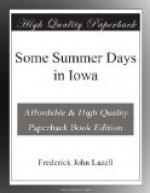[Illustration: “Cattle beneath the trees would make the same picture” (p. 116)]
* * * * *
It is worth while to spend a little time with the friendly golden-rod which spreads all over upland and lowland almost as generous as the sunshine. To many of us one stalk of golden-rod looks much like another, but a very little study will readily enable us to distinguish between the different species and will add wonderfully to its interest and charm. There is the tall, smooth stemmed golden-rod, with saw toothed leaves, except near the base and ample pyramids of medium-sized clusters of blossoms; this is the solidago serotina, or late golden-rod. A similar golden-rod, but with hairy stems and smaller flower clusters is the solidago Canadensis or Canada golden-rod. Both these grow in the bottoms anywhere near the creek. Along the moist clay banks the elm-leaved golden-rod shows its tall stem with the leaves which give the plant its distinctive name, surmounted by several threadlike spreading branches strung with little bits of leaves and clusters of yellow blossoms at the ends, as if the slender, curving, green branches had been dipped in gold dust. On the same slopes may usually be found the zig-zag or broad-leaved golden-rod, with leaves as broad as the palm of a lady’s hand and little wand-like clusters of blossoms, several of them from the axil of each leaf. This plant is called the zig-zag golden-rod because its stem often turns first one way and then the other, as if it hadn’t made up its mind which way to grow. Higher up on the dry rocky banks is the gray or field golden-rod, whose small leaves are covered with grayish down and whose rather short stem is topped by a flattish pyramid of brilliant yellow flowers. This is one of the early golden-rods, but it lasts well into the fall. Another handsome species which is fairly common is the solidago rigida, or hard-leaved golden-rod, whose leaves are thick, rough and fairly broad, the lower ones sometimes a foot long, and whose flower clusters form a broad flat top. Each cluster is very large, containing twenty-five or thirty flowers if you care to pull one to pieces and count them. One stem will have several hundred of these flower clusters and each cluster contains twenty-five flowers on an average, a fine example of Nature’s wealth and bounty.




